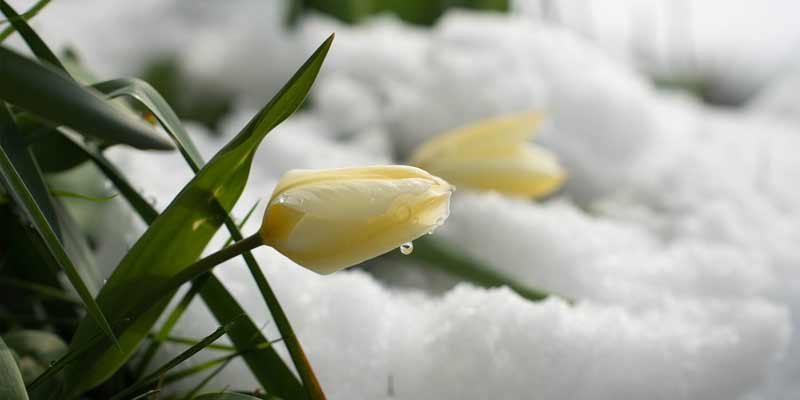With their graceful stems and vibrant petals, tulips embody springtime beauty as they captivated gardeners and flower enthusiasts for centuries originating from regions such as Turkey and Central Asia. The diversity in color; and the elegant forms – these beloved flowers offer a visual feast. Yet, like many flowering bulbs, tulips encounter challenges with temperature drops; this is especially true during frosty conditions.
This article delves into the captivating realm of tulips, probing their cold tolerance, reactions to frost, and winter protection strategies – a crucial understanding for gardeners aiming to successfully nurture these exquisite blooms.
Exploring the World of Tulips
The lily family, Liliaceae, houses a diverse range of species and cultivars collectively known as tulips (Tulipa spp.). Each member boasts unique characteristics and growing requirements. Renowned for their showy flowers are these perennial bulbs which offer an extensive palette of colors: from striking reds and yellows to delicate pinks – even purples.
Spring heralds the end of winter dormancy with its early blooms, particularly emblematic are tulips. These flowers typically thrive in cool climates and well-drained soils; they prosper best under temperate conditions that promote their growth and development.
Yet, a challenge presents itself due to the susceptibility of tulips to frost. Freezing temperatures can jeopardize their delicate flowers and tender foliage – an inherent vulnerability.
Understanding Frost and Its Effects on Tulips
When temperatures drop below freezing, water vapor in the air crystallizes into ice, which is frost. Frost presents a formidable danger to tulips during their vulnerable growth stages; specifically when shoots thrust out from the soil and start forming flower buds. The effects of frost on tulips vary factors such as exposure duration, temperature fluctuations, and plant developmental stage significantly influence these variations.
Depending on their species, cultivar, and geographic origin, tulips demonstrate varying levels of cold tolerance. Some varieties of tulips exhibit more resilience to frost than others; however, if we subject them for an extended period to freezing temperatures it may damage their tender tissues: this impairment could affect flower development, and compromise the health of the entire plant in general.
Assessing Frost Damage in Tulips
Careful observation and an understanding of a tulip’s physiological responses to cold stress are necessary for identifying frost damage. Frost damage may appear externally as foliage that is discolored or water-soaked, flowers that are wilted or distorted, and stunted growth. In severe instances, necrosis or tissue death could be evident in frost-damaged tulips; this leads to the collapse of affected tissues and diminishes their aesthetic appeal.
Upon closer inspection, freezing temperatures may have caused cellular damage, as frost-damaged tulip bulbs often appear soft or mushy. Although tulips can display remarkable resilience in adversity; severe frost damage compromises their bulb health, thus diminishing their capacity for vigorous growth during future seasons.
6 Strategies for Protecting Tulips from Frost
Several strategies exist for gardeners to safeguard tulips from the damaging effects of frost and enhance their resilience in a garden.
1. Planting Depth
To insulate tulip bulbs from fluctuating temperatures and frost heaving, plant them at the appropriate depth. Planting guidelines suggest a depth equivalent to three times their diameter; this rule not only provides adequate protection against frost but also promotes proper root development and stability.
2. Mulching
Straw or shredded leaves are examples of organic mulch and can be applied as a layer around tulip bulbs. This action regulates both soil temperature and moisture levels; further, it acts as an insulating barrier – minimizing the adverse effects that frost-induced winter dormancy can have on bulbs through its ability to curb temperature fluctuations.
3. Site Selection
Select planting sites should provide shelter from cold winds and frost pockets, ideal locations include south-facing slopes and spaces in proximity to buildings or trees. When choosing a site for tulips; ensure that the soil is well-drained with good air circulation. This not only mitigates potential risks of frost damage but also fosters optimal growth conditions for these flowers.
4. Frost Protection
Forecasted frost necessitates the action of covering emerging tulip shoots and flower buds with lightweight fabric or floating row covers; this traps heat, creating a microclimate that promotes plant survival. During daylight hours to prevent overheating and ensure adequate sunlight as well as air circulation for the tulips, it is essential to remove these coverings.
5. Watering Practices
Ensure tulips receive sufficient hydration without becoming waterlogged by maintaining consistent soil moisture levels during the growing season; this will enhance their ability to withstand frost. The key lies in minimizing water stress and promoting cellular resilience, factors critical for a robust response to cold temperatures.
6. Timely Maintenance
Regularly monitor tulips for any signs of frost damage; promptly remove all damaged or diseased foliage to halt the spread of pathogens. With sterilized tools, prune affected tissues: this promotes healthy growth and diminishes the risk of secondary infections during each growing season.
Conclusion
Concluding, tulips – renowned for their beauty and resilience – are not impervious to the detriments of frost and freezing temperatures. To guarantee longevity in the garden, one must take essential steps such as understanding a tulip’s cold tolerance; moreover, they should implement proactive protection strategies.
Gardeners can enhance tulips’ resilience to frost and promote their thriving throughout seasons by optimizing planting depth; and applying mulch effectively – selecting suitable planting sites is crucial. Further steps, such as providing frost protection, and maintaining optimal watering practices – all underpinned with timely maintenance– are paramount for the successful cultivation of these vibrant flowers.
Diligence, patience, and a profound appreciation for the intricate interplay between plants and their environment ultimately pave the way to successful tulip cultivation in frost-prone regions. With meticulous care and attention, one can ensure that tulips continue gracing gardens with their exquisite blooms; these serve as symbols of nature’s enduring cycle – embodying both beauty and resilience.



Leave a Reply